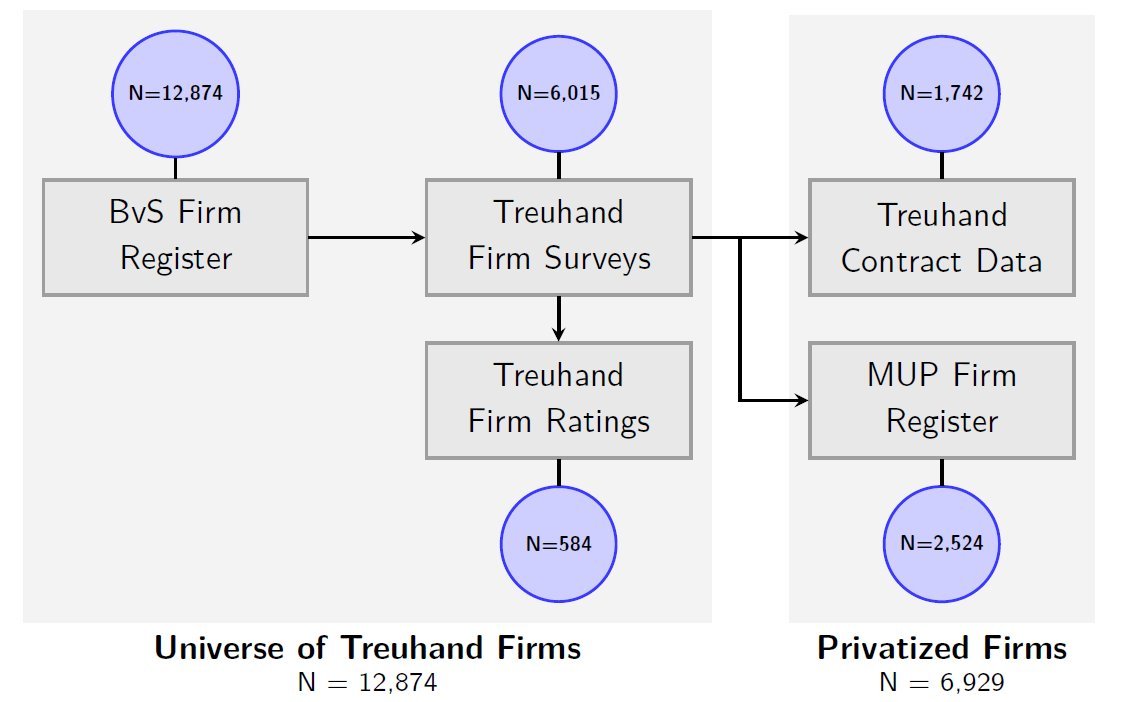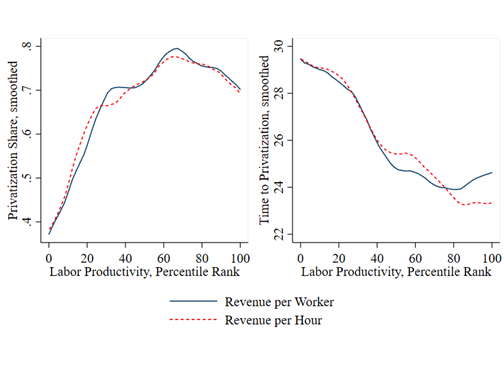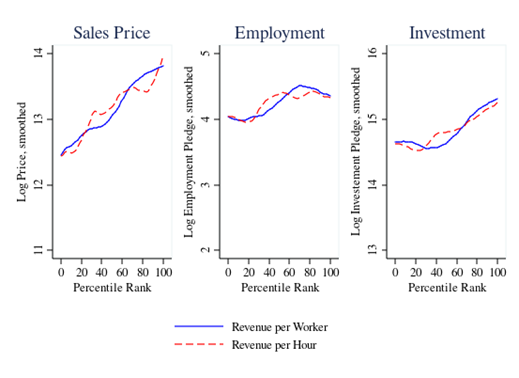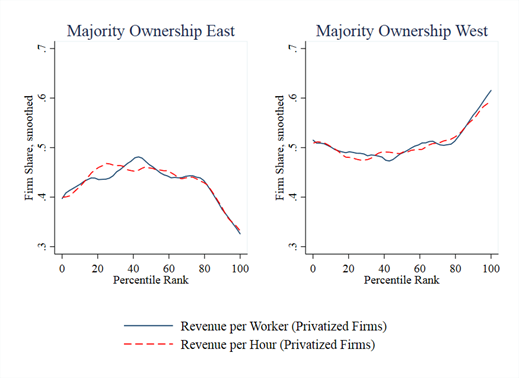(1) 30ys ago, Germany started one of historys most radical privatization programs. Transforming East Germany’s economy, its legacy lasts until today.
New paper: We analyze what happened (w @AAoritz @LukasMergele). Thread https://abs.twimg.com/emoji/v2/... draggable="false" alt="👇" title="Rückhand Zeigefinger nach unten" aria-label="Emoji: Rückhand Zeigefinger nach unten"> #EconTwitter #HistoryTwitter
https://abs.twimg.com/emoji/v2/... draggable="false" alt="👇" title="Rückhand Zeigefinger nach unten" aria-label="Emoji: Rückhand Zeigefinger nach unten"> #EconTwitter #HistoryTwitter
https://www.cesifo.org/node/58093 ">https://www.cesifo.org/node/5809...
New paper: We analyze what happened (w @AAoritz @LukasMergele). Thread
https://www.cesifo.org/node/58093 ">https://www.cesifo.org/node/5809...
(2) Founded by the last Communist government and shaped by Germany’s post-reunification institutions, a public agency called #Treuhandanstalt was responsible for privatizing East Germany’s state-owned economy. Essentially, it became the world’s largest holding company.  https://abs.twimg.com/emoji/v2/... draggable="false" alt="🏢" title="Bürogebäude" aria-label="Emoji: Bürogebäude">
https://abs.twimg.com/emoji/v2/... draggable="false" alt="🏢" title="Bürogebäude" aria-label="Emoji: Bürogebäude">
(3) The program remains hugely controversial. Millions of people lost their jobs. Fierce protests ensued. Miners went on hunger strikes. The #Treuhandanstalt’s director was assassinated. Today, less than 10% of East Germans consider the transition successful.
(4) Analysis: We study the privatization process and its outcomes regarding the #Treuhandanstalt’s mandate to privatize economically viable firms. We use labor productivity at the beginning of the program as an indicator of firms’ competitiveness.
(5) Our data: We obtained registers of East German firms through Freedom of Information requests. We dusted off old documents in the National archives ( @Bundesarchiv), dug up old survey and administrative data, and paired these with long-term firm ownership panels ( @ZEW).
(6) Public debate: Did the #Treuhandanstalt close economically competitive firms in East Germany?
Result 1: Firms with higher initial labor productivity were (a) more likely to be privatized and (b) privatized faster.
Result 1: Firms with higher initial labor productivity were (a) more likely to be privatized and (b) privatized faster.
(7) Public debate: Were firms sold at low prices?
Result 2: Firms with higher initial labor productivity were sold at higher prices and earned larger employment and investment pledges from investors.
Result 2: Firms with higher initial labor productivity were sold at higher prices and earned larger employment and investment pledges from investors.
(8) Public debate: Did the #Treuhandanstalt sell the best firms to West Germans?
Result 3: Firms with higher initial productivity are also significantly more likely to be sold to new owners from West Germany.
Result 3: Firms with higher initial productivity are also significantly more likely to be sold to new owners from West Germany.
(10) Public debate: Did West Germans conduct killer acquisitions?
Result 5: West German ownership of firms is associated with higher rates of long-term survival, compared to East German ownership.
Result 5: West German ownership of firms is associated with higher rates of long-term survival, compared to East German ownership.
(11) In sum: We demonstrate redistribution of firm ownership from East to West. While we document firm closure even at the top of the productivity distribution, on average, Treuhand achieved better outcomes for better firms. Firms acquired by West Germans more likely to survive.
(12) Broader lessons? (i) Our results suggest positive selection of firms into privatization. (ii) Productivity differences inherited from central-planning predict firm survival under capitalism. (iii) East Germany’s peaceful revolution entailed loss of local control over wealth.
(13) We& #39;re thankful for help along the way from @krisztinaorban @nandinigupta201 @gerardrolanducb @essobecker @simonhhess @kbburchardi @MSchularick @ulrichthekaiser
(14) May be worth a look for @S_Stantcheva @wwwojtekk @tylercowen @ralphdehaas @BJavorcik @ufukakcigit @BrankoMilan @DrDaronAcemoglu @florianederer @gabriel_zucman @PikettyLeMonde @ianbremmer  https://abs.twimg.com/emoji/v2/... draggable="false" alt="😇" title="Lächelndes Gesicht mit Heiligenschein" aria-label="Emoji: Lächelndes Gesicht mit Heiligenschein">
https://abs.twimg.com/emoji/v2/... draggable="false" alt="😇" title="Lächelndes Gesicht mit Heiligenschein" aria-label="Emoji: Lächelndes Gesicht mit Heiligenschein">

 Read on Twitter
Read on Twitter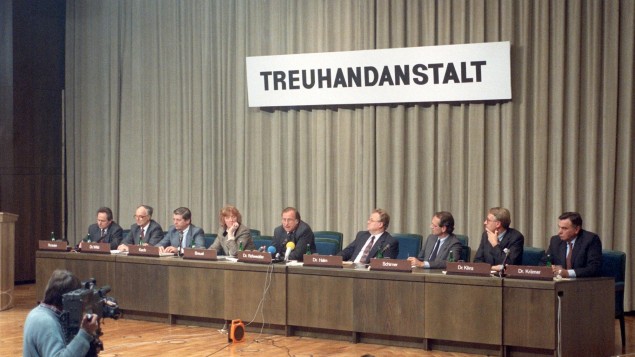 #EconTwitter #HistoryTwitter https://www.cesifo.org/node/5809..." title="(1) 30ys ago, Germany started one of historys most radical privatization programs. Transforming East Germany’s economy, its legacy lasts until today. New paper: We analyze what happened (w @AAoritz @LukasMergele). Thread https://abs.twimg.com/emoji/v2/... draggable="false" alt="👇" title="Rückhand Zeigefinger nach unten" aria-label="Emoji: Rückhand Zeigefinger nach unten"> #EconTwitter #HistoryTwitter https://www.cesifo.org/node/5809...">
#EconTwitter #HistoryTwitter https://www.cesifo.org/node/5809..." title="(1) 30ys ago, Germany started one of historys most radical privatization programs. Transforming East Germany’s economy, its legacy lasts until today. New paper: We analyze what happened (w @AAoritz @LukasMergele). Thread https://abs.twimg.com/emoji/v2/... draggable="false" alt="👇" title="Rückhand Zeigefinger nach unten" aria-label="Emoji: Rückhand Zeigefinger nach unten"> #EconTwitter #HistoryTwitter https://www.cesifo.org/node/5809...">
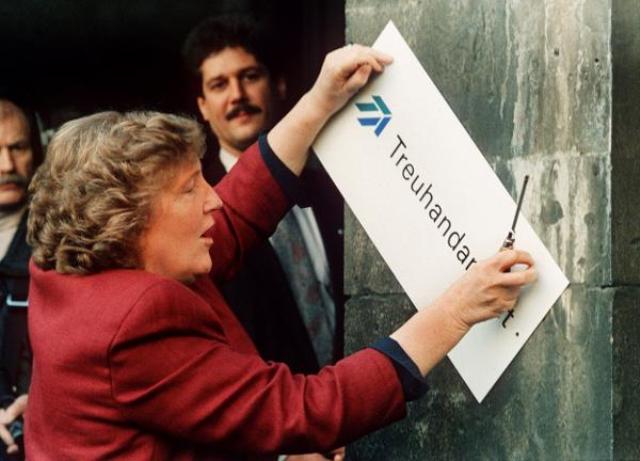 #EconTwitter #HistoryTwitter https://www.cesifo.org/node/5809..." title="(1) 30ys ago, Germany started one of historys most radical privatization programs. Transforming East Germany’s economy, its legacy lasts until today. New paper: We analyze what happened (w @AAoritz @LukasMergele). Thread https://abs.twimg.com/emoji/v2/... draggable="false" alt="👇" title="Rückhand Zeigefinger nach unten" aria-label="Emoji: Rückhand Zeigefinger nach unten"> #EconTwitter #HistoryTwitter https://www.cesifo.org/node/5809...">
#EconTwitter #HistoryTwitter https://www.cesifo.org/node/5809..." title="(1) 30ys ago, Germany started one of historys most radical privatization programs. Transforming East Germany’s economy, its legacy lasts until today. New paper: We analyze what happened (w @AAoritz @LukasMergele). Thread https://abs.twimg.com/emoji/v2/... draggable="false" alt="👇" title="Rückhand Zeigefinger nach unten" aria-label="Emoji: Rückhand Zeigefinger nach unten"> #EconTwitter #HistoryTwitter https://www.cesifo.org/node/5809...">
 #EconTwitter #HistoryTwitter https://www.cesifo.org/node/5809..." title="(1) 30ys ago, Germany started one of historys most radical privatization programs. Transforming East Germany’s economy, its legacy lasts until today. New paper: We analyze what happened (w @AAoritz @LukasMergele). Thread https://abs.twimg.com/emoji/v2/... draggable="false" alt="👇" title="Rückhand Zeigefinger nach unten" aria-label="Emoji: Rückhand Zeigefinger nach unten"> #EconTwitter #HistoryTwitter https://www.cesifo.org/node/5809...">
#EconTwitter #HistoryTwitter https://www.cesifo.org/node/5809..." title="(1) 30ys ago, Germany started one of historys most radical privatization programs. Transforming East Germany’s economy, its legacy lasts until today. New paper: We analyze what happened (w @AAoritz @LukasMergele). Thread https://abs.twimg.com/emoji/v2/... draggable="false" alt="👇" title="Rückhand Zeigefinger nach unten" aria-label="Emoji: Rückhand Zeigefinger nach unten"> #EconTwitter #HistoryTwitter https://www.cesifo.org/node/5809...">
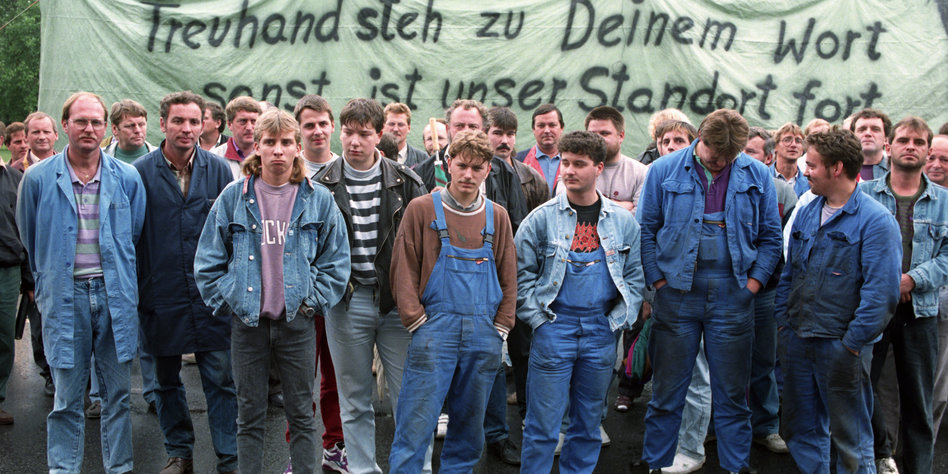 #EconTwitter #HistoryTwitter https://www.cesifo.org/node/5809..." title="(1) 30ys ago, Germany started one of historys most radical privatization programs. Transforming East Germany’s economy, its legacy lasts until today. New paper: We analyze what happened (w @AAoritz @LukasMergele). Thread https://abs.twimg.com/emoji/v2/... draggable="false" alt="👇" title="Rückhand Zeigefinger nach unten" aria-label="Emoji: Rückhand Zeigefinger nach unten"> #EconTwitter #HistoryTwitter https://www.cesifo.org/node/5809...">
#EconTwitter #HistoryTwitter https://www.cesifo.org/node/5809..." title="(1) 30ys ago, Germany started one of historys most radical privatization programs. Transforming East Germany’s economy, its legacy lasts until today. New paper: We analyze what happened (w @AAoritz @LukasMergele). Thread https://abs.twimg.com/emoji/v2/... draggable="false" alt="👇" title="Rückhand Zeigefinger nach unten" aria-label="Emoji: Rückhand Zeigefinger nach unten"> #EconTwitter #HistoryTwitter https://www.cesifo.org/node/5809...">
